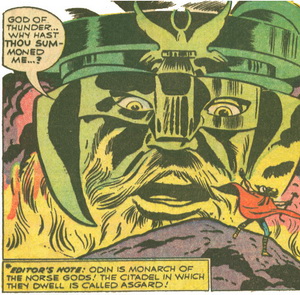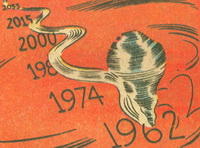
Published: November, 1962
Plot: Stan Lee
Script: Larry Lieber
Pencils: Jack Kirby
Inks: Dick Ayers
Letters: Art Simek
Last time I wandered in the Marvelous Zone, I met up with a double dose of large, green and mean–though he was not as mean as you would expect, just sort of talkative and aggravated. But this time, I’m following Thor, and I’m happy to see this story is a mere 13 pages in the November ’62 issue of Journey into Mystery. Whew! That should make things a little easier! Will I get 3,000 words out of this story? Won’t know till I’m done. So let’s get started.
On the cover of JIM #86 we see Thor in fine form, wielding Mjolnir for all he’s worth, but meeting with a good deal of frustration because his foe, the Tomorrow Man, is apparently a time traveler who “can fade into a different year” before Thor can reach him. With Hulk, it was all about the very realistic threat of the Commies, but this will be a tale with mystical and science fiction elements.
–Russ
CREDIT WHERE CREDIT IS DUE
Now here’s something interesting: on the splash, we see that the “Plot” is by Stan Lee, but the “Script” is the product of Larry Lieber. To the best of my knowledge, this is the first time we’re making a distinction between plot and script. Also, Jack Kirby once again provides “Art,” but Dick Ayers is given credit for “Inks.”
It’s worth noting at this point that Larry Lieber is Stan Lee’s younger brother, a writer and artist who was extremely involved in all aspects of Marvel Comics from the 1950’s (before Marvel Comics was even known as Marvel Comics), right up to the present day. At one point, Larry remarked, “Stan made up the plot, then he’d give it to me, and I’d write the script.” But he actually did a lot more than that. It’s amazing how much work he did for Marvel, and if you can keep up with the pace of his prolific professional life, you might like to take a side-trip in the Marvelous Zone and read about it here.
HAIL! THE FUTURE!
We begin three centuries into the future, with the optimistic proclamation that “mankind has abolished war and scrapped its weapons! Peace and contentment prevail…” Hey! Are we sure Gene Roddenberry doesn’t need some kind of credit on the splash? This sounds suspiciously like the Utopia depicted in the Star Trek universe (or perhaps Gene Roddenberry should give a little tip of the hat to Marvel Comics!). And like the Star Trek universe, even though peace and contentment prevail, for some reason everyone is still dressing like it’s the 1960’s.
 Of course here, just as in Star Trek, Utopia is disrupted by a single ornery individual who just can’t seem to get with the program. Zarrko has invented a time machine and decides to travel back to the twentieth century in search of weapons.
Of course here, just as in Star Trek, Utopia is disrupted by a single ornery individual who just can’t seem to get with the program. Zarrko has invented a time machine and decides to travel back to the twentieth century in search of weapons.
In the twentieth century, Thor is helping the military test anti-missiles. Zarrko materializes in the middle of the tests, steals the cobalt bomb and gets away before Thor can stop him. From a small piece of unrecognizable metal left behind, the conclusion is drawn that the thief is from the future, and Thor calls on Odin for help. Odin advises him to strap the metal fragment to Mjolnir, since “thy hammer has the power to spin faster than light–to enter the fourth dimension of–time!”
Taking dad’s advice, Thor arrives in the year 2262, where in addition to learning that Zarrko arrived a month earlier with the cobalt bomb and is using it as a threat to establish his dictatorship, we also find that the women of the future still consider Thor quite handsome. (I know that’s probably not germane, but I found it interesting and amusing, thus this quick mention of Thor’s universal appeal.)
 Zarrko and Thor face off, but at every turn, Thor outsmarts him. Zarrko flees in a spaceship, reasoning, “If I can’t use the cobalt bomb to enslave the world–then I’ll use it to destroy the world!” Thor thumps Mjolnir to create a storm, and Zarrko’s ship crashes. Thor retrieves the bomb and returns it to 1962.
Zarrko and Thor face off, but at every turn, Thor outsmarts him. Zarrko flees in a spaceship, reasoning, “If I can’t use the cobalt bomb to enslave the world–then I’ll use it to destroy the world!” Thor thumps Mjolnir to create a storm, and Zarrko’s ship crashes. Thor retrieves the bomb and returns it to 1962.
Zarrko survives the crash, but loses his memory. Amnesia! Yep. And since in the future we are all such peace-loving hippies, it’s a good bet there’s no death penalty, not even for a tyrant who attempts to destroy the entirety of civilization. I predict Zarrko will live long enough to regain his memory (despite the medic’s proclamation that this will never happen) and someday, somehow, we’ll run into him again, up to his old tricks. And once again the handsome, resourceful Thor will have to step in to save the future.
SAVE THE FUTURE?
Now, having said all that, here’s my question: Why? Why do we need to save the future? If something goes wrong in the past, sure, let’s get right on it, let’s put history back in its proper place, or we may wake up tomorrow and find there IS no tomorrow. But if the people of the future have problems, what’s it to us? Why should we meddle?
Well, I guess I’m showing my self-centered nature here. I wouldn’t meddle. But then again, I’m not Thor. I don’t have the heart of a superhero, a demi-god. If I did, I would care about all people in all places at all times. Maybe that’s part of what makes Thor who he is, this overwhelming desire to protect everyone. I hearken back to the Spider-Man sentiment that with great power comes great responsibility. I don’t have the power, so I don’t feel the responsibility. But obviously Thor does, and I’m glad he does, otherwise we wouldn’t have much of a story.
BUILDING THE MYTHOS
Two significant events happen in this story to recommend it as an important moment in Marvel history. First, this tale marks the first appearance of Odin.
 Along with this imposing image of Odin, an Editor’s note informs us that “Odin is monarch of the Norse gods! The citadel in which they dwell is called Asgard!” Odin is a god and monarch of the first degree, his speech liberally peppered with “thee’s” and “thou’s.” For the moment, he is merely a fount of important information, but we shall see much more of him in the future.
Along with this imposing image of Odin, an Editor’s note informs us that “Odin is monarch of the Norse gods! The citadel in which they dwell is called Asgard!” Odin is a god and monarch of the first degree, his speech liberally peppered with “thee’s” and “thou’s.” For the moment, he is merely a fount of important information, but we shall see much more of him in the future.
The information Odin provides is the other significant development. Apparently Thor has the power to transcend time, simply by spinning “faster than light.” Wow! You mean, in addition to everything else, Thor can also travel through time? And he doesn’t even need a time machine? Well, he needs the hammer of course, but then he needs the hammer for everything he does, or else he turns back into Blake. But learning this, I have just gained an increased appreciation for Thor. And I can’t wait to see how this superpower might be utilized in future stories.
 Other than that, there’s not a whole lot going on here. Thor uses his powers to save the day, and at the end, Jane Foster laments that Dr. Blake is “colorless” and she wishes she could work for Thor instead.
Other than that, there’s not a whole lot going on here. Thor uses his powers to save the day, and at the end, Jane Foster laments that Dr. Blake is “colorless” and she wishes she could work for Thor instead.
Really?
Work for Thor? What would she do? Type his letters? Answer his phones? Does Thor really need an assistant? And how does she think he’s going to pay her, anyway? Not a very realistic daydream. That Jane, she’s one crazy romantic, isn’t she?
GENERAL ROSS?
Now, since Russ is the administrator of the Marvel Chronology Project and he has begun calling on me to help him determine matters of Marvel Comics chronology (as if he would ever really need my help with that!), I should mention one thing that jumped out at me. On the bottom of page 3, several military officials at the missile testing site are singing the praises of Thor.
 Mustachioed gentleman on the right…is that General Ross? Foe of the Incredible Hulk? And if it is, what is he doing in a Thor story? Well, testing missiles, of course! But if so… When? Before or after the last Hulk story? And more importantly… Why? Why is he using Thor to help test missiles?
Mustachioed gentleman on the right…is that General Ross? Foe of the Incredible Hulk? And if it is, what is he doing in a Thor story? Well, testing missiles, of course! But if so… When? Before or after the last Hulk story? And more importantly… Why? Why is he using Thor to help test missiles?
We’re told that Thor is assisting so the scientists can observe “a human’s physiological reaction” to the cobalt bomb explosion. We’re told they’re using Thor because he is one of few people in the world who could potentially survive such an explosion. Yes, well, but…if “an ordinary man would be killed, standing that close to a cobalt bomb explosion,” but Thor will not be killed–because he is not, in fact, an ordinary man–then what good are the results of this test?
The only valuable information they will get from this test is whether or not a being with SUPERPOWERS can survive the blast of a cobalt bomb. And if that’s the case and Thor does survive, then General Ross will no doubt roar, “Fiddlesticks!” (though he would probably use a word more emphatic than “Fiddlesticks!”). He would exclaim, “$#!+! If Thor can survive the cobalt bomb, what the £>¢|< good will it be against HULK?”
I’m being facetious, of course, but the logic here defies reason, so a little facetiousness is not beyond reason. I don’t know if there’s anything else in the Marvel mythology to support my thesis that Ross is using Thor to perfect weapons to use against Hulk, but think about it: What is Ross’ one defining characteristic? He’s hell-bent on destroying the Hulk! Would he go to any lengths to achieve that goal? Would he even go so far as to endanger the life of the always good-natured and helpful demi-god Thor? If so, General Ross demands a cold hard look, and possible inclusion on my Villain Valuation chart.
But I digress. We don’t know any of this for certain about Ross, and besides, I’m here to talk about Thor and the Tomorrow Man. The moniker “Tomorrow Man” does indeed sound fantastic and supernatural, and frankly I was a bit disappointed when he turned out to be nothing more than a power-hungry creep from the future who just happens to have a time machine. Sure, he gives Thor a bit of trouble with his hidden room of magnetic mirrors, Delta-Electron gun and army of giant robots, but Thor handily defeats Zarrko at every turn. Thor even uses a decoy when first approaching Zarrko, proving he is not only strong, but also clever. Thor is a hero of many talents, and the Tomorrow Man is no match.
SHADOWED FIGURES
 There are two shadowed figures in this story. One is the decoy I just alluded to, and is quickly unveiled as such. But the other, much more mysterious, appears on the missile testing site, thinking, “We are certainly lucky to have the services of the mighty Thor!”
There are two shadowed figures in this story. One is the decoy I just alluded to, and is quickly unveiled as such. But the other, much more mysterious, appears on the missile testing site, thinking, “We are certainly lucky to have the services of the mighty Thor!”
Who is this shadowy figure? Why does he merely think his gratitude to Thor, and not express it aloud? Is this someone who may appear in a later tale, fully revealed, but for the moment must remain hidden? Does General Ross, in his  just behind the door, about to throw the plot into even further turmoil and confusion.
just behind the door, about to throw the plot into even further turmoil and confusion.
Russ has explained to me there’s a very good chance this figure is in shadow simply because Jack Kirby decided he’d done enough work for one day, and it was a lot easier to draw shadows than to flesh out the details. Yes, yes. That’s probably it. He probably needed to catch the train and get home to his wife’s meatloaf dinner, or if he was late again, there would be hell to pay.
Okay. That’s my story, and I’m sticking with it. But if at any time in the future, I run into a mysterious shadowed figure in the background, I’m going to remember this, and see if I can make these puzzle pieces fit.
![]() Next time we wander through the Marvelous Zone, it’s a Riches to Rags, then Rags to Riches story. Lights! Camera! Action! and lots of it when we travel to the “stars”!
Next time we wander through the Marvelous Zone, it’s a Riches to Rags, then Rags to Riches story. Lights! Camera! Action! and lots of it when we travel to the “stars”!
| Want to read this comic on your computer? Marvel has a scan! Want to own this story? Buy the Masterworks! |















I hate to correct you, but Odin 1st appeared last issue on the last page, panel 4. It names him, and he has a line.
I like your catch of Thunderbolt Ross at the test range. Also, the guy at the end holding the C-Bomb looks a lot like Dr. Banner.
I also like the shadowy figure bit. Makes sense to me that he is the Cancer Man from the X-Files! 🙂
I think that Thor was a little slow on responding to Zarrko stealing the C-Bomb.
Say what you will about future fashion, but the guards got the Buck Rogers look down.
It’s a good thing Zarrko didn’t kill Decoy Thor right off the bat.
If there are no weapons in the future then where did the Delta-Electron Gun from?
I think another key point here is that a robot can hold Thor’s hammer.
I bet Zarrko wished he shut the window on the spaceship. You can lose more bombs that way.
“I’m going to track down that Tomorrow-Man!!”-Thor
Great catch on Odin! You had me running to the bookshelves for the Marvel Masterworks, and yep…sure enough! Odin makes a shadowy appearance at the end of JIM85. I didn’t catch it because he is very “shadowy,” but…there he is, and he has (as you mention) “a line.”
Thanks for all your observations. These stories are so rich, there is no end to observations!